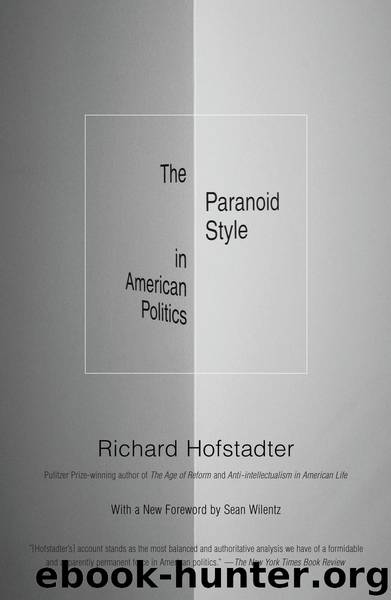The Paranoid Style in American Politics by Richard Hofstadter

Author:Richard Hofstadter
Language: eng
Format: epub, azw3
Published: 2018-09-13T16:00:00+00:00
I
T HE taking of the Philippine Islands from Spain in 1899 marked a major historical departure for the American people, a breach in their traditions and a shock to their established values. To be sure, from their national beginnings they had constantly engaged in expansion, but almost entirely into contiguous territory. Now they were extending themselves to distant extra-hemispheric colonies. They were abandoning a strategy of defense hitherto limited to the continent and its appurtenances, in favor of a major strategic commitment in the Far East. Thus far their expansion had been confined to the spread of a relatively homogeneous population into territories planned from the beginning to develop self-government; now control was to be imposed by force on millions of ethnic aliens. The acquisition of the islands, therefore, was understood by contemporaries on both sides of the debate, as it is readily understood today, to be a turning point in our history.
To discuss the debate in isolation from other events, however, would be to deprive it of its full significance. America’s entrance into the Philippine Islands was a by-product of the Spanish-American War. The Philippine crisis is inseparable from the war crisis, and the war crisis itself is inseparable from a larger constellation that might be called “the psychic crisis of the 1890’s.”
Central in the background of the psychic crisis was the great depression that broke in 1893 and was still very acute when the agitation over the war in Cuba began. Severe depression, by itself, does not always generate an emotional crisis as intense as that of the nineties. In the 1870’s the country had been swept by a depression of comparable acuteness and duration which, however, did not give rise to all the phenomena that appeared in the 1890’s or to very many of them with comparable intensity and impact. It is often said that the 1890’s, unlike the 1870’s, form a “watershed” in American history. The difference between the emotional and intellectual impact of these two depressions can be measured, I believe, not by the difference in severity, but rather by reference to a number of singular events that in the 1890’s converged with the depression to heighten its impact upon the public mind.
First in importance was the Populist movement, the free-silver agitation, the heated campaign of 1896. For the first time in our history a depression had created a protest movement strong enough to capture a major party and raise the specter, however unreal, of drastic social convulsion. Second was the maturation and bureaucratization of American business, the completion of its essential industrial plant, and the development of trusts on a scale sufficient to stir the anxiety that the old order of competitive opportunities was approaching an eclipse. Third, and of immense symbolic importance, was the apparent filling up of the continent and the disappearance of the frontier line. We now know how much land had not yet been taken up and how great were the remaining possibilities for internal expansion both in business and
Download
The Paranoid Style in American Politics by Richard Hofstadter.azw3
This site does not store any files on its server. We only index and link to content provided by other sites. Please contact the content providers to delete copyright contents if any and email us, we'll remove relevant links or contents immediately.
The Secret History by Donna Tartt(18852)
The Social Justice Warrior Handbook by Lisa De Pasquale(12143)
Thirteen Reasons Why by Jay Asher(8800)
This Is How You Lose Her by Junot Diaz(6796)
Weapons of Math Destruction by Cathy O'Neil(6148)
Zero to One by Peter Thiel(5690)
Beartown by Fredrik Backman(5600)
The Myth of the Strong Leader by Archie Brown(5427)
The Fire Next Time by James Baldwin(5250)
How Democracies Die by Steven Levitsky & Daniel Ziblatt(5129)
Promise Me, Dad by Joe Biden(5088)
Stone's Rules by Roger Stone(5027)
A Higher Loyalty: Truth, Lies, and Leadership by James Comey(4846)
100 Deadly Skills by Clint Emerson(4842)
Rise and Kill First by Ronen Bergman(4705)
Secrecy World by Jake Bernstein(4651)
The David Icke Guide to the Global Conspiracy (and how to end it) by David Icke(4628)
The Farm by Tom Rob Smith(4439)
The Doomsday Machine by Daniel Ellsberg(4419)
